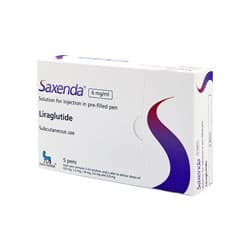Login to your account
- Prescription included
- Genuine medication
- All-inclusive service - No hidden fees
- Free next-day delivery
Understanding Saxenda Side Effects
Explore Liraglutide's Side Effects and Management Strategies
Saxenda is a licensed weight loss medication that contains an active ingredient called Liraglutide. This is a type of GLP-1 agonist, similar to Semaglutide (the active ingredient in Wegovy).
Before starting any kind of treatment that helps you lose weight, it’s important to learn the potential side effects. This page will list common and uncommon side effects, as well as advice on how to manage them.
What are the most common side effects of Saxenda?
Just like any medicine, there’s a chance you’ll experience side effects from Saxenda. For most people, side effects are worse when you start treatment. But, as your body adjusts to the medicine they tend to improve.
The most common side effects include:
| Very common | Common |
|---|---|
|
|
Please note: While these side effects are common, not everyone who takes Saxenda will experience them.
Gastric issues
According to scientific research and studies on Saxenda, the most commonly observed side effects were gastric-related. This includes symptoms like:
- nausea (most common)
- vomiting
- constipation
- diarrhoea
- stomach pain or upset

While gastric issues are very common when taking GLP-1 agonist medications, they usually go away after several days or weeks.
This is because your body needs time to adjust to the new medicine. You may also notice that gastric issues return each time you increase your dose - although it likely won’t be as bad as when you first started treatment.
Tiredness
Another common side effect of Saxenda is tiredness or fatigue. People who are obese often feel chronically tired due to their weight, so you may not notice a huge difference when taking Liraglutide injections.

For others, however, Saxenda may cause you to feel even more tired compared to normal.
It’s not entirely clear why Saxenda causes fatigue, but one plausible explanation is that it’s down to a sudden decrease in your food intake, which affects your energy levels.
Injection site reaction
Saxenda is administered via an injection pen. It is inserted into subcutaneous fat (the fat that lies just beneath your skin).

If you inject yourself in the same place repeatedly, you may experience something called an injection site reaction. This could look like:
- bruising
- pain
- irritation
- itching
- rash
How to manage:
To avoid this from occurring, make sure to change the injection site each time you administer Saxenda. The best places to inject include the abdomen (tummy), upper thighs and upper arms.
Low blood sugar (hypoglycaemia)
If you have type 2 diabetes, Saxenda may cause your blood sugar levels to become too low. This is referred to as hypoglycaemia.

Signs of low blood sugar include:
- hunger
- dizziness
- anxiety
- irritability
- sweating
- shaking
- heart palpitations
How to manage:
If you experience any of these symptoms, you should eat or drink something high in sugar. Fruit juice, chocolate, honey or sweets will quickly release glucose into your blood.
What are the less common side effects of Saxenda?
The following side effects are much less common. However, it’s important to know of any potential risks when starting a new medication, even with low odds.
|
|
- Pancreatitis: Inflammation of the pancreas has been observed in some patients treated with Liraglutide. While reportings have been rare, pancreatitis is a potentially life-threatening condition. Signs include severe abdominal pain that reaches as far as the back, as well as nausea and vomiting.
- Gallbladder problems: Treatment with Saxenda has been associated with an increased risk of gallbladder problems, including inflammation.
- Increased heart rate: If you notice that you have a faster pulse compared to usual, consult a healthcare professional.
- Kidney problems: Although rare, it is possible to experience reduced kidney function or kidney failure while taking Liraglutide. Signs of kidney failure include a reduction in urine volume, a metallic taste in the mouth and easy bruising.
- Serious allergic reactions: There’s a chance of suffering a severe allergic reaction in response to Saxenda. Get emergency help if you have difficulty breathing, swelling of the face or a fast heartbeat.
- Depression and anxiety: While taking Saxenda, pay attention to any changes to your mental state. Speak with a health professional if you find yourself having any concerning thoughts or feelings.
Please note: This list does not cover all the potential side effects of Saxenda. For more information on rare side effects, please consult the patient information leaflet.
Does Saxenda cause cancer?
There is no current evidence to suggest that Liraglutide or other GLP-1 medications can cause cancer in humans.
However, there have been studies on rats and mice that linked Liraglutide with an increased risk of thyroid tumours, including cancerous tumours.
Stop taking Saxenda and tell your doctor immediately if you experience a lump or swelling in your neck, hoarseness, trouble swallowing or shortness of breath.
Do Saxenda side effects go away?
Saxenda side effects usually last a few days or weeks, but for some people, they may be present throughout the entirety of treatment.
In general, side effects will be most difficult at the start of your treatment. As your body adjusts to the new medicine, they will gradually subside.
The same goes for dose increases. As your body needs time to adjust to a higher dose, you may notice side effects returning for a short period.
Everyone reacts differently, so there’s no way of predicting how you’ll feel.
Please note: You must follow the dosage instructions carefully when taking Saxenda. Starting on the lowest dose and gradually increasing each month gives your body time to adjust. That way, you minimise side effects by building up a tolerance to the medicine.
How can I manage Saxenda side effects?
You can manage Saxenda side effects with the help of lifestyle changes or by adjusting your dosage.
Lifestyle and diet changes
To help improve nausea and other gastric-related problems:
- eat mostly bland foods, like crackers, white rice and bread
- avoid lying down straight after a meal
- if you struggle to keep down solid foods, stick to liquids like broths and smoothies
- open windows to let in some fresh air
- eat slowly and mindfully (to help aid digestion and recognise the sensation of fullness)
- stay hydrated throughout the day and eat high-fibre foods (to prevent constipation)

Foods to avoid while on weight loss treatment include:
- fatty foods (processed meats, fast food, cheese, cream, butter)
- sugary foods (cakes, pastries, chocolate, sweets, fruit juices, sodas, jams)
- salty foods (crisps, white shop-bought bread, frozen pizzas, canned soups)
- alcohol
Dosage adjustments
You’re most likely to experience Liraglutide side effects when you first start treatment and when your dose increases.
To prevent side effects from a dose increase, you can choose to remain on the same dose for longer than 4 weeks, so your body has more time to adjust. Equally, you can go back down a dose if you find side effects too challenging.
When should I report side effects?
Unfortunately, nausea and other gastric issues are very common when you start taking Liraglutide, or other GLP-1 medications. While your doctor can advise you on managing symptoms, there isn’t much you can do while your body is adjusting to the treatment.
However, if you experience any rare or concerning side effects, you should always report them to your doctor. It may be possible that Saxenda isn’t safe for you to continue.
Regular check-ups are encouraged so that a medical professional can observe your progress and check that you’re responding well to the medication.
Want to learn more about Saxenda?
Click hereFurther reading


Foods to avoid during weight loss treatment: a practical ...
Reviewed by Dr. Caroline Fontana
How many calories do I need to lose weight?
Reviewed by Dr. Caroline Fontana
Mysimba’s side effects and management
Reviewed by Dr. Caroline Fontana
Understanding Wegovy side effects
Reviewed by Dr. Caroline FontanaSelect
medicationFill out a short
medical formDoctor issues
prescriptionMedication sent
from pharmacy

